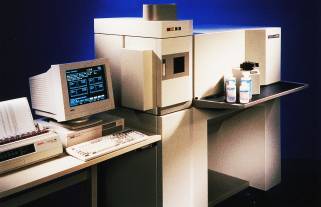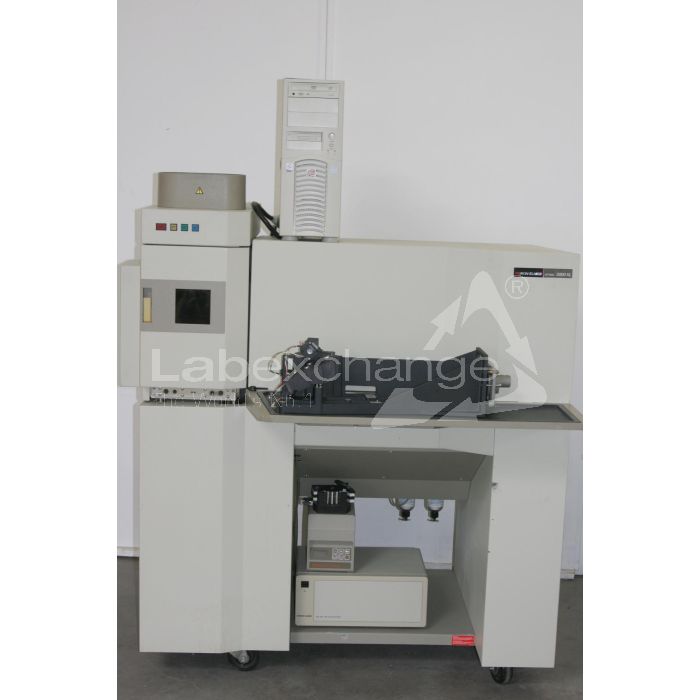Perkin Elmer Optima 3000 XL
| Objektnummer | B00024445 |
|---|---|
| Seriennummer | 024445 |
| Object Naam | Perkin Elmer Optima 3000 XL |
| Status | Stock unit |
Product groep: ICP systemen
Status, leverings- en betalingsvoorwaarden
Apparatuurcontrole
De gebruikte apparatuur wordt voorafgaand aan levering gecontroleerd door Labexchange Service GmbH. U ontvangt volledig functionerende apparatuur.
Verzending
De vermelde verzendtijden zijn telkens de kortste voor een artikel. In bepaalde gevallen kunnen de daadwerkelijke verzendtijden daarvan afwijken. De uiteindelijke verzendtijden worden aangegeven in de opdrachtbevestiging.
In de regel bieden we combinatieleveringen aan. Levertijden zijn afhankelijk van het artikel met de langste levertijd. Deelleveringen zijn mogelijk tegen een toeslag.
Verzendmethoden
Koeriersdiensten, transportbedrijven, zelf afhalen, levering door Labexchange wagenpark
Informatie levering
De prijzen zijn exclusief verzendkosten. De genoemde verzendkosten zijn de te verwachten kosten. Afwijkingen zijn mogelijk. In het geval geen kosten voor verzending zijn gespecificeerd, vraag die dan afzonderlijk aan.
De opgegeven vracht- en verpakkingskosten hebben betrekking op de goedkoopste transportroute en zijn onder voorbehoud van onvoorziene kostenstijgingen. Door onvoorziene gebeurtenissen kunnen vrachttarieven en levertijden op elk moment veranderen en moeten ze worden aangepast aan de huidige situatie. Incoterm coderingen volgens Incoterms 2010: Bij afhalen EXW, CFR voor zendingen over zee, CPT per luchtfracht, andere zendingen DAP. Opmerking: We geven geen preferentieel certificaat/EUR1 af. Bij zelf afhalen/af fabriek (EXW) uit derde landen en de EU wordt 16% btw als borg ingehouden, tot we de ontvangstbevestiging/het leveringscertificaat van de koper hebben ontvangen.
Betalingsvoorwaarden
Wij accepteren geen betalingen Letter of Credit, PayPal etc. Het factuurbedrag is volledig verschuldigd. Er zijn geen betalingskortingen. De goederen blijven tot volledige betaling ons eigendom.
|
Land |
Mogelijke betaalmethoden |
Opmerking |
|
Duitsland, Oostenrijk, Zwitserland |
Betaling via factuur, vooruitbetaling, per creditkaart |
Betaling via factuur is mogelijk voor ondernemingsklanten. |
|
Nederland, België en Luxemburg |
Betaling via factuur, vooruitbetaling, per creditkaart |
Betaling via factuur is mogelijk voor ondernemingsklanten. |
|
Andere landen |
vooruitbetaling, per creditkaart |
|
Onze Algemene Voorwaarden voor Verkoop, Levering en Betaling zijn hierop van toepassing. Deze voorwaarden zijn hier te downloaden.
Tussenverkoop is ons voorbehouden.
Beschrijving status:
Alle artikelen zijn gebruikte artikelen, tenzij bij een artikel uitdrukkelijk wordt vermeld dat het om een nieuw apparaat gaat.
Firma: Perkin Elmer
Nachfolgende Abbildungen und Beschreibungen sind modellbezogen und aus Prospekten entnommen.
Sie geben nicht den Lieferumfang des Systems wieder.
Den exakten Lieferumfang entnehmen Sie bitte aus dem Angebotstext.

Optima 3000XL ICP-Emissionsspektrometer
Vollautomatisch arbeitendes Emissionsspektrometer für die simultane Multielementanalyse von Lösungen mit ICP-Anregung. Für höhere Nachweisstärken wird ein axiales Plasma genutzt. Das System besteht aus einem Spektrometer einschließlich Polychromator, Probeneinführungssystem, HF-Generator, Steuerrechner mit Farbbildschirm und Drucker.
Optik
Der von Perkin-Eimer entwickelte optische Aufbau nutzt ein Gitter, das für den UV-Bereich optimiert wurde. Dieses Gitter weist 79 Linien/mm mit einem Blaze-Winkel von 63° auf. Um eine möglichst getreue Abbildung zu erzielen, wird das gestreute Licht in zwei Bereiche unterteilt-. Der sichtbare Bereich wird mit einem Prisma weiter unterteilt, während der UV-Bereich von einem Schmidt Cross Disperser zerlegt wird.
Der Schmidt Cross Disperser hat drei Aufgaben: (1) Durch ihn wird das Licht in UV- und VIS-Bereich unterteilt. Dies erfolgt mit einem Loch in der Mitte: das Licht in der Mitte gelangt ungehindert zum Prisma während (2) der UV-Bereich vom mit Linien versehenen Randbereich weiter dispergiert wird. (3) Eine weitere Aufgabe besteht darin, die spährische Aberation der Kamera-Ebene zu korrigieren. Diese Konstruktion bewirkt eine hohe Lichtausbeute und eine hervorragende Auflösung.
Der einzigartige optische Aufbau hat folgende Vorteile:
Die simultane Messung der analytischen Linie und des Untergrundes führt zu verbesserter Präzision und höherem Analysendurchsatz. Eine Auflösung von < 7 pm im unteren UV-Bereich. Eine sehr hohe UV-Quantenausbeute führt zu verbesserten Nachweisgrenzen. Ein hoher dynamischer Bereich umfaßt Konzentrationen von ppb bis %. Random access readout bedeutet: alle Subarrays können einzeln gelesen werden, um ein Maximum an Flexibilität zu erzielen. Die Detektoren werden auf -40°C gekühlt, was zu einem sehr niedrigen Dunkelstrom führt. Die Isolierung und Thermostatisierung der Optik bei 38°C führt zu einer hervorragenden Wellenlängenstabilität.
Probeneinführungssystem
Das Probeneinführungssystem ist leicht zugänglich: Zwei Türen, eine vorn, eine an der Seite, ermöglichen einen guten Zugang zum Probeneinführungssystem, das als Schnellwechseleinheit eingesetzt ist. Die Vordertürenthältein FensterzurBeobachtung des Plasmas. Sicherungseinrichtungen überwachen das querliegende Plasma.
Das Probeneinführungssystem besteht aus einerzerlegbaren Fackel (das äußere und mittlere Rohr sind fest miteinander verbunden, um ein stabiles Plasma zu gewährleisten), einem Aluminiumoxid-Injektor, einer RytonSprühkammer (beständig gegen alle gebräuchlichen Aufschlußsäuren einschl. Flußsäure und Königswasser sowie organische Lösungsmittel).
Die zerlegbare Fackel enthält standardmäßig einen Aluminiumoxid-Injektor mit 2 mm Innendurchmesser. Verschiedene Innendurchmesser sind aus Aluminiumoxid und Quarz verfügbar. Der Abstand des Injektors kann relativ zur HF-Spule justiert werden.
Ein Cross-Flow-Zerstäuber mit Ryton-Endkappe und Aluminiumoxid-Düseneinsätzen wird als Standard-Zerstäuber eingesetzt. Weitere Typen (Meinhard, Sharp-Cone-Spray, van-der-Plas, Ultraschall) sind als Option erhältlich. Das Zerstäuber-Gas wird durch einen software-gesteuerten Mass-Flow-Controller reguliert.
Eine Computer-gesteuerte Drei-Kanal-Hochpräzisions-Schlauchpumpe dient der Probenzuführung und dem Abpumpen des Ablaufs (der dritte Kanal kann für Sonderanwendungen genutzt werden).
Hochfrequenz-Generator
Ein freilaufender 40-MHz-Generator dient zur Leistungseinkoppelung in das Plasma. Ein freilaufender Generator reagiert trägheitslos auf Laständerungen im Plasma durch Frequenzverschiebung. Die Leistung kann mittels Software im Bereich zwischen 750 und -1500 VV in Intervallen von 5 VV eingestellt werden. Die Leistung wird in einem Regelkreis (True Power Control: TPC) geregelt.
Der HF-Generator nutzt eine luftgekühlte Keramik-Leistungsröhre, die elektronisch, thermisch und mechanisch stabil ist. Sie wurde konzipiert, um eine hohe Zuverlässigkeit, lange Lebensdauer und eine einfache
Wartung zu vereinen. Um die Lebensdauer zu erhöhen wird der Heizstrom (tube filament) abgeschaltet, wenn die Röhre nicht benutzt wird. Die HF-Abschirmung entspricht den FCC- und VDE-Richtlinien.
Computer und Drucker
Die Optima 3000-Software verwendet den DEC-Rechner 466d2LPv und den EPSON-Drucker LQ-870. Die Funktion der Software wird nur in dieser Konfiguration gewährleistet.
Personal Computersystem DECpc 466d2LPv mit ISA-Bus, 80486d2 32-Bit Prozessor, 66 MHz, 8 MB Speicher (max. 64 MB), 3S-805 Graphikprozessor mit 1 MB DRAM, 426 MB SCSI Festplatte, 525 MB SCSI Bandlaufwerk, 3571,44 MB Diskettenlaufwerk, 2 freie 16-Bit Steckplätze. Schnittstellen parallel und 2 seriell. Farbmonitor 17, Länderkit und Tastatur.
EPSON LQ-870-Matrixdrucker mit 24 Nadeln, 80 Zeichen/Zeile, bis 300 Zeichen/sec-, bis 90 Zeichen/sec in Schönschrift; Graphik mit 360 Punkten/ Zoll Auflösung, RS-232C- und Centronics-Parallel-Schnittstellen und Centronics-Anschlußkabel.
Software-Paket
Enthält Optima 3000 Software, UNIX-Betriebssystem für DEC-Rechner, Optima 3000 Handbücher, Overlay, IEEE-488 Kabel, 3,5"-Leerdisketten und Druckerpapier.
Die Optima 3000 Software ist multitaskingfähig. Sie ermöglicht ein Höchstmaß an Flexibilität und eine einfache Bedienung. Das Software-Konzept ermöglicht sowohl eine einfache Routineoperation wie auch eine ausgefeilte Methodenoptimierung. Einige Merkmale der Software sind-.
Standardbedingungen und -einstellungen-, globale Änderungen eines ausgewählten Datensatzes: Wellenlängenbibliothek mit 50.000 Einträgen; Speicherung und Darstellung von Spektren; hochauflösende Graphik; automatische Zentrierung des Analytkanals auf der optischen Achse des Spektrometers-, Piktogramme zur Zustandsanzeige des Spektrometers; Interelement-Korrektur und multiple interne Standards.
Weitere, hochentwickelte Software-Merkmale sind:
Auto-Integrationszeit-Bestimmung: Hiermit wird vor Beginn der Messung die Integrationszeit fürjedes einzelne Subarray dem emittierten Licht in diesem Wellenlängenbereich angepaßt, so daß eine optimale Zählstatistik resultiert. Die automatische dynamische Untergrundkorrektur legt die Untergrundkorrekturpunkte anhand der spektralen Störungen bei jeder einzelnen Wiederholung und jedem Subarray individual fest. Neuberechnung einerAnalyse mit geänderten Parametern (z.B. korrigierte manuell gesetzte Untergrundkorrekturpunkte oder Standardkonzentrationen) mit Hilfe von gespeicherten Spektren, ohne daß die Lösungen neu gemessen werden müssen. Die Optimierung mit Directed Search (gezielte Suche) unterstützt eine schnelle Methodenoptimierung. Multicomponent Spectral Fitting (MSF) dient zur mathematischen Filterung von spektralen Störungen. Quasi-Macro-Programmierung mit Hilfe von EXEC-Files dient der weitgehenden Automatisierung.
Kompressor (wahlweises Zubehör)
Zwei Kompressoren.
Probenautomat AS-91 (wahlweises Zubehör)
Computergesteuertes Probenaufgabesystem zur vollautomatischen, sequentiellen Multielementbestimmung mit spezieller Versorgungseinheit mit drei austauschbaren Probentabletts. Steuerung erfolgt über die Betriebssoftware des ICP Spektrometers. Auswechselbare Probentabletts mit 152 Probenpositionen für 15-mL-Probengefäße (im Lieferumfang enthalten) oder 218 Positionen für 6-mL-Gefäße oder 55 Positionen für 50-mL-Gefäße (Option) und eine Position für einen Waschbehälter, PTFEProbenkapillare mit 0,6-mm-Innendurchmesser.
Ultraschallzerstäuber CETAC U-5000AT (wahlweises Zubehör)
Zubehör zur ICP-AES und ICP-MS zur Steigerung der Empfindlichkeit und des Nachweisvermögens. Komplette Einheit, bestehend aus Ultraschallzerstäuber, Umlaufkühlung (benötigt 2.5 L Kühlmittel, z.B. Diethylenglycol) und Laborwagen.







